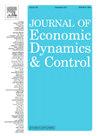A robust asymptotic control model to analyze climate policy with CDR options
IF 2.3
3区 经济学
Q2 ECONOMICS
引用次数: 0
Abstract
A three-region optimal economic growth model is proposed to represent the global energy transition to net-zero emissions when carbon dioxide removal (CDR) technologies are available. The main features of the model are (i) the representation of the economy and energy use with nested CES production functions; (ii) the representation of climate policy through the use of a safety cumulative emissions budget concept; and (iii) the introduction of an international emissions trading scheme for the implementation of climate policy. Using an infinite horizon optimal control paradigm, several contrasting scenarios are analyzed both in an asymptotic steady state or “turnpike” point, and in an optimal transition to sustainability. This very compact model produces dynamic path simulations that are consistent with the main recommendations from IPCC for long term climate policies. The potential use of this simple model in future developments in climate and economic modeling is discussed.
具有CDR选项的气候政策鲁棒渐近控制模型分析
本文提出了一个三区域最优经济增长模型,用于描述二氧化碳去除技术可用时全球能源向净零排放的过渡。该模型的主要特点是(i)用嵌套的消费电子产品生产函数来表示经济和能源使用;(ii)通过使用安全累积排放预算概念来表示气候政策;(三)为实施气候政策而引入国际排放交易计划。使用无限视界最优控制范式,分析了在渐近稳定状态或“收费公路”点和在可持续性的最优过渡中的几种对比情景。这个非常紧凑的模型产生的动态路径模拟与IPCC关于长期气候政策的主要建议相一致。讨论了这个简单模型在未来气候和经济模式发展中的潜在用途。
本文章由计算机程序翻译,如有差异,请以英文原文为准。
求助全文
约1分钟内获得全文
求助全文
来源期刊

Journal of Economic Dynamics & Control
ECONOMICS-
CiteScore
3.10
自引率
10.50%
发文量
199
期刊介绍:
The journal provides an outlet for publication of research concerning all theoretical and empirical aspects of economic dynamics and control as well as the development and use of computational methods in economics and finance. Contributions regarding computational methods may include, but are not restricted to, artificial intelligence, databases, decision support systems, genetic algorithms, modelling languages, neural networks, numerical algorithms for optimization, control and equilibria, parallel computing and qualitative reasoning.
 求助内容:
求助内容: 应助结果提醒方式:
应助结果提醒方式:


